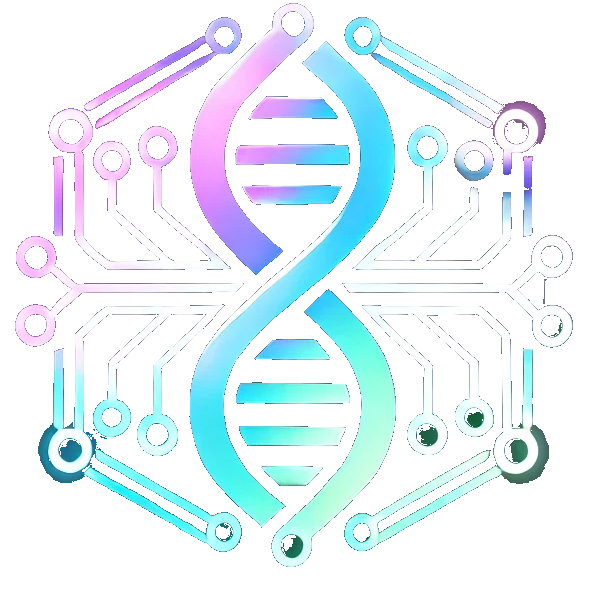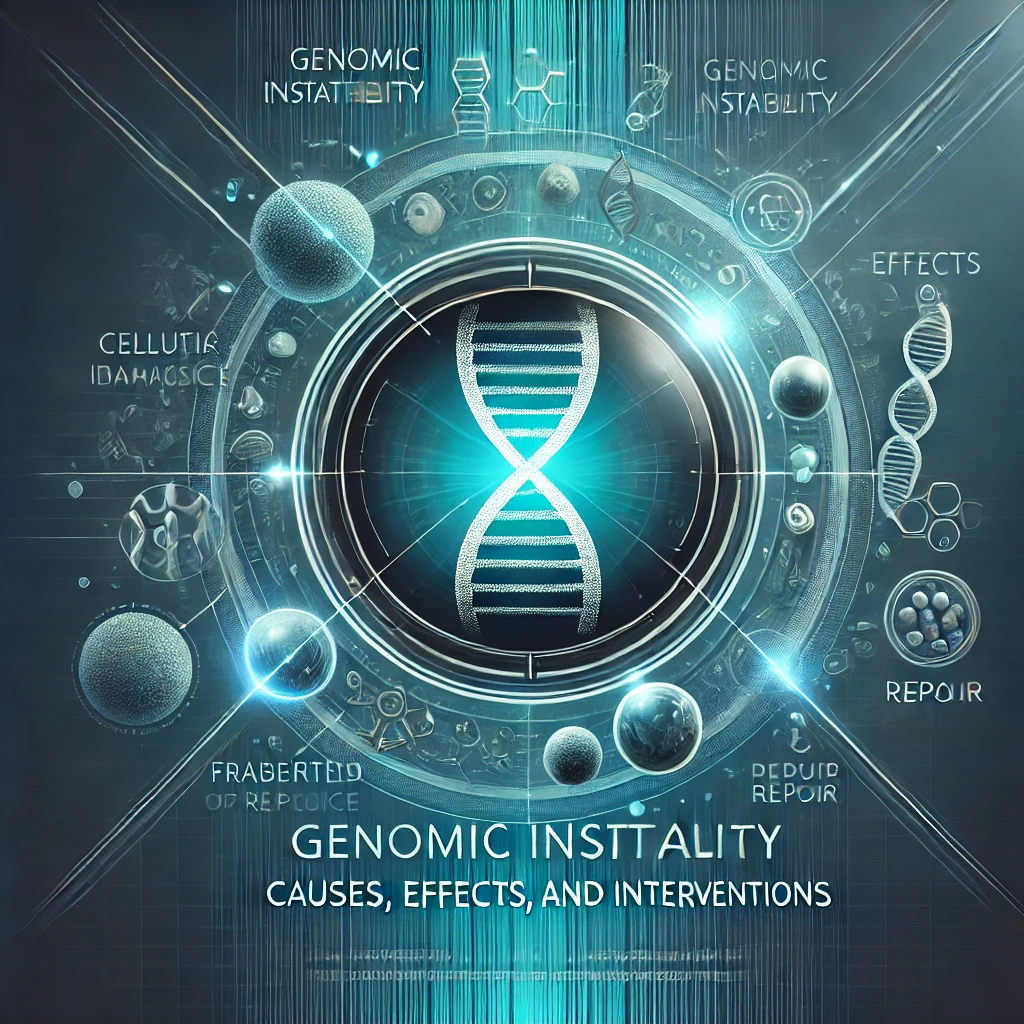1. Genomic Instability
Description
- Genomic instability refers to the accumulation of DNA damage (mutations, double-strand breaks, chromosomal rearrangements) caused by both internal (e.g., reactive oxygen species, replication errors) and external factors (e.g., UV radiation, chemical carcinogens).
- Over time, unrepaired DNA lesions can lead to cell dysfunction, senescence, or malignant transformation.
Potential Interventions
- Enhancing DNA Repair Pathways
- NAD⁺ Boosters (e.g., nicotinamide riboside, nicotinamide mononucleotide)
- NAD⁺ is crucial for the activity of DNA repair enzymes such as PARPs and sirtuins. Supporting NAD⁺ levels may improve the cells’ ability to fix DNA damage.
- Sirtuin Activators
- SIRT1 and related sirtuins participate in DNA repair. Activating these enzymes (via lifestyle, certain supplements, or drugs) can potentially improve genomic maintenance.
- NAD⁺ Boosters (e.g., nicotinamide riboside, nicotinamide mononucleotide)
- Antioxidants and Oxidative Stress Reduction
- Dietary Antioxidants (fruits, vegetables rich in vitamins C, E, and polyphenols)
- They help neutralize reactive oxygen species (ROS), which can cause DNA damage.
- Mitochondrial-Targeted Antioxidants (e.g., MitoQ)
- Specifically designed to accumulate in mitochondria and reduce ROS production at the source.
- Dietary Antioxidants (fruits, vegetables rich in vitamins C, E, and polyphenols)
- Lifestyle Modifications
- Avoiding Excessive UV Exposure and Carcinogens (e.g., smoking)
- Reduces exogenous DNA-damaging agents.
- Caloric Restriction or Intermittent Fasting
- May reduce oxidative stress and improve cellular repair capacity.
- Avoiding Excessive UV Exposure and Carcinogens (e.g., smoking)
2. Telomere Attrition
Description
- Telomeres are repetitive nucleotide sequences at the ends of chromosomes, acting like protective caps.
- With each cell division, telomeres shorten. When they reach a critically short length, cells enter senescence or apoptosis, limiting regenerative capacity.
Potential Interventions
- Maintaining Telomere Length
- Telomerase Activators (e.g., TA-65 from astragalus extracts)
- Telomerase is the enzyme that can elongate telomeres. However, its effectiveness in humans is still debated, and uncontrolled telomerase activation may carry a cancer risk.
- Telomerase Activators (e.g., TA-65 from astragalus extracts)
- Reducing Oxidative Stress
- Lifestyle Factors (regular moderate exercise, balanced diet, sufficient sleep)
- Oxidative stress accelerates telomere shortening. A healthier lifestyle is linked to slower telomere attrition.
- Lifestyle Factors (regular moderate exercise, balanced diet, sufficient sleep)
- Stress Management
- Psychological Stress has been associated with accelerated telomere shortening.
- Meditation, mindfulness, and avoiding chronic stress can help preserve telomere length.
3. Epigenetic Alterations
Description
- Epigenetic changes involve modifications to DNA or histones (e.g., methylation, acetylation) that alter gene expression without changing the DNA sequence itself.
- With age, the epigenetic landscape becomes dysregulated, leading to misexpression or silencing of key genes, which contributes to functional decline.
Potential Interventions
- Lifestyle and Dietary Interventions
- Caloric Restriction (CR) and Intermittent Fasting
- Shown to modify epigenetic markers linked to aging.
- Exercise
- Regular physical activity can positively reshape the epigenetic profile, influencing genes involved in metabolism and inflammation.
- Caloric Restriction (CR) and Intermittent Fasting
- Sirtuin Modulation
- SIRT1 (and other sirtuins) are epigenetic regulators influencing chromatin structure.
- Compounds like resveratrol (found in grapes and red wine) and certain NAD⁺ boosters may support sirtuin activity.
- Epigenetic Reprogramming (Experimental)
- Partial Reprogramming with Yamanaka factors (e.g., OCT4, SOX2, KLF4, c-MYC)
- In lab settings, these factors have reversed epigenetic age in cells and even in some animal models, though human clinical application remains experimental.
- Partial Reprogramming with Yamanaka factors (e.g., OCT4, SOX2, KLF4, c-MYC)
4. Loss of Proteostasis
Description
- Proteostasis (protein homeostasis) is the cellular system ensuring proteins are correctly folded, functional, and that damaged proteins are degraded.
- Aging cells show a decline in chaperone function, proteasome efficiency, and autophagy, leading to protein misfolding and aggregation (e.g., amyloid plaques in Alzheimer’s disease).
Potential Interventions
- Enhancing Autophagy
- mTOR Inhibitors (e.g., rapamycin) and AMPK Activators (e.g., metformin)
- Inhibiting mTOR or activating AMPK promotes autophagy, helping clear out damaged proteins.
- Intermittent Fasting / Exercise
- Both can boost autophagic processes, improving proteostasis.
- mTOR Inhibitors (e.g., rapamycin) and AMPK Activators (e.g., metformin)
- Pharmacological Chaperones
- Chemical chaperones or molecules that stabilize protein folding (currently in various stages of research).
- Heat Shock Proteins (HSP) modulators (e.g., HSP70 inducers) may help maintain protein quality control.
- Proteasome Enhancement
- Polyphenols and Other Compounds
- Some plant-derived compounds have been reported to enhance proteasome activity in model organisms.
- Reduced Oxidative Damage
- Maintaining low oxidative stress helps the proteasome function more efficiently, preventing the buildup of protein aggregates.
- Polyphenols and Other Compounds
Summary
- The primary hallmarks of aging—genomic instability, telomere attrition, epigenetic alterations, and loss of proteostasis—are considered the foundational triggers driving cellular aging.
- Interventions range from lifestyle adjustments (caloric restriction, exercise, stress reduction) and nutritional supplementation (antioxidants, NAD⁺ precursors, potential telomerase activators) to pharmacological agents (metformin, rapamycin, sirtuin modulators).
- While many of these interventions have shown promise in laboratory and animal models, human evidence for robust anti-aging effects is still emerging. Nonetheless, combining healthy lifestyle measures with targeted therapies holds the greatest potential for addressing these primary contributors to aging.
o1



